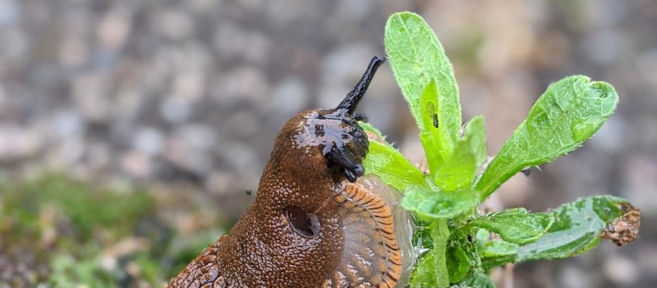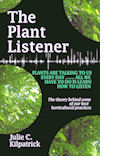Wage War on Slugs
They are every gardener's nemesis, capable of destroying a single plant in one sitting and able to devastate whole rows of seedlings.
Anyone who has carefully nurtured trays of bedding plants in the greenhouse only to bed them out and have them disappear in the night will have an abiding hatred of slugs. They like tender, soft, green growth, their rasping mouthparts can take care of most delicate plants and they seem inordinately attracted to hostas. You couldn't blame any gardener for wanting to commit mass murder on these slimy little horrors.
Slugs belong to the order of molluscs which puts them in the same category as mussels, cockles, snails and even octopus and squid. Unlike many of their relatives, slugs are shell-less. Without a portable home to shelter in, they have to find other means of shelter and protection so, the first tactic in the battle against slugs is to deprive them as much as possible of a place to hide.
Slugs have moist bodies which dry out very quickly so they must not allow themselves to be exposed to sunlight. This is why they produce slime - to keep their bodies moist. Because of this, they mostly come out on wet days or at night. However, they don't actually like rain to fall directly on them so they tend to wait until just after rainfall to emerge. So, if you plan to go slug hunting, choose a nice, moist day, immediately after the rain or do it at night.
They are sensitive creatures too. They prefer to travel over soft ground where their bodies won't be damaged and we can use this to our advantage by surrounding favoured plants with eggshells or gravel in an attempt to put them off.
As of 1st April 2022, use of slug pellets containing metaldehyde is banned in the UK and they haven't been available on the shelves for a while. Metaldehyde in slug pellets was not only toxic to slugs, but to other animals too and the ban reflects that.
Replacment slug pellets containing iron phosphate are sold as 'organic', 'non-toxic' and 'not harmful to beneficial animals'. Iron phosphate works as a stomach poison to slugs, damaging their digestive system until, eventually, they can no longer eat and starve to death. Todays slug pellets are often referred to as 'pet safe' but there is some concern that, if ingested in enough amounts, it could lead to acute toxicity in dogs especially.
If you do intend to use slug pellets, take extra care to keep them well out of reach of children and pets and use them sparingly. Alternatively, try one or all of the methods below.
You can buy biological pesticides for killing slugs and these usually come in the form of tiny nematode worms. The worms are suspended in a liquid which you simply water into the soil. They are parasites of slugs and burrow into them, killing them in around three days. This seems quite a cruel death for the poor slugs but it is kinder to the environment than chemical means so, if nothing but death to all slugs is your aim, biological control is the way to go.

The old method of placing beer traps is still very effective. Simply place a container of beer into the soil with a few centimetres of the rim above the ground, enough so the slug can climb over it - this is to avoid trapping friendly animals such as ground beetles. The slugs are attracted to the beer but they don't necessarily fall into the trap and drown as most might think. Only a few of the slugs attracted to beer traps are unlucky enough to drown in them. Far more will have a drink and move on. Slugs will travel over quite a distance towards the smell of the yeast in beer so don't put the traps anywhere near your prized plants. Instead, place them in a part of the garden where you don't mind the slugs having a meal with their drink. Near the compost heap for example, or under a hedge.
Some slugs are quite happy in your compost bin. They feed on the fresh material you put in there, helping to break it down and their eggs are usually eaten by other inhabitants of the compost so, no need to worry about the eggs being carried back to your garden in the finished compost. If you can't stand the thought of killing the slugs you pick off your plants, the compost heap is probably the best place for them.

Keep your eye out for leopard slugs (pictured above). These guys are definitely worth having around and many are killed by gardeners who don't know they're actually friends. Leopard slugs are omnivores. They will chase and eat other slugs and they only eat dead plant material and fungi so they keep your garden nice and tidy too.
Much as we gardeners might hate slugs, we shouldn't wish for their total destruction because they are food for so many more lovable creatures. Toads, hedgehogs, centipedes, frogs, slow-worms, rove beetles and many species of birds regularly eat slugs. If you encourage these creatures into your garden, they will reward you by eating enough slugs to keep the population under control. A little saucer of milk and some dog food should bring hedgehogs to your door every night and you can create shelters for slow-worms, rove beetles and centipedes by providing a warm, dark place for them to hide in during the day. Frogs and toads will happily move into a small pond.
Anyone who has tried to grow hostas knows the frustration brought about by a slug attack. Slugs are attracted to hostas because hostas like the same damp conditions that slugs prefer. You can grow hostas and many other plants by mulching around them with sharp grit or gravel. Slugs hate to travel over sharp things because it damages their skin so they won't risk attacking your favourite plants. You can put up barriers like this around any plants you feel might be at risk and it is true that gravel gardens rarely suffer from slug damage.
If you are growing the kind of vegetable plants slugs like, such as lettuce, plant these out in the open, away from damp hiding places so the slugs have to break cover and expose themselves to predators to get to them.
Slugs have a preference for certain herbaceous plants over others so, by process of elimination, you can eventually create a garden where slugs are rarely a problem. Day lilies, hardy geraniums and achilleas, for example, rarely constitute a decent meal for any self-respecting slug, whereas hostas, delphiniums and hollyhocks appear to be favourites. Experiment with your plants and, if they can't stand up to the slugs, get rid of them in favour of something else.
The trouble with slugs is that they're pretty much self-regulating. On any given site, they usually breed only up to numbers that can be sustained by the available food. When you remove slugs from the population, the ones that are left simply go into breeding mode and lay more eggs. Many slugs and snails have a 'homing instinct'. So, if you throw your slugs over the fence, they will eventually return to where they came from.
There is nothing worse than waking up in the morning to find all your young vegetable plants decimated by slugs but there are worse enemies to have than the slug. Between the slugs themselves and their natural predators, their populations are kept under control. A few eaten plants is a small price to pay for a garden that is alive with birds and other creatures. Give me that any day over a sterile environment where nothing else lives but rows and rows of lettuce.
Julie is a lecturer in horticulture, editor of Gardenzine and author of the book The Plant Listener







